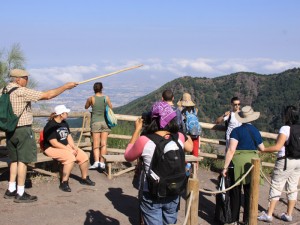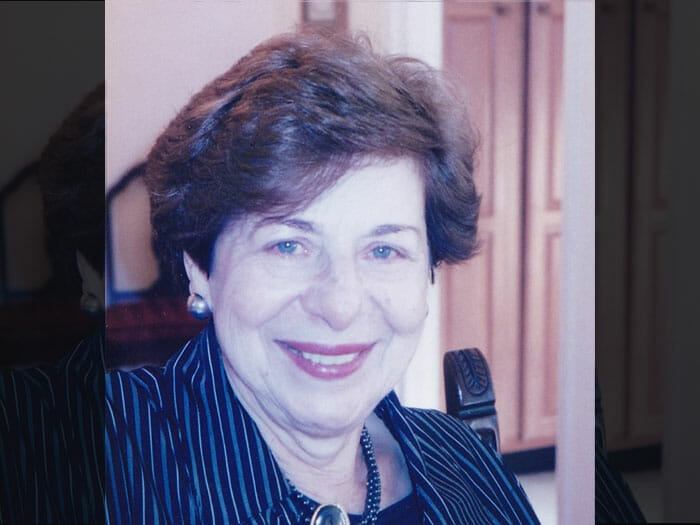
The class stops at a scenic overlook to orient themselves within the Italian landscape on the walk up to the caldera of Mt. Vesuvius.
The geologic and cultural history of the first-century Roman Empire came alive for 12 College of Staten Island students last summer thanks to Professor Anderson Ohan’s 13-day geology field course at the Mt. Vesuvius region of Italy.
View the CSI Today Photo Gallery.
The four-credit course, Geology 547, provided a supervised study of the eruptive history of the only active volcano on the European continent. The response was so positive; he plans to take another group there this summer.
During their summer in Italy, the students visited the town of Pozzuolo, the Temple Serapis, the Solfataras, and the Isle of Capri, accumulating data and gaining knowledge about the geologic and volcanic history of the Mt. Vesuvius area. They stayed at the Vesuvian International Institute in Castellammare di Stabia; overlooking the Bay of Naples and Mt. Vesuvius. The institute, a former monastery, is equipped with a dining room, classrooms, and numerous computers.
Jen Burtner, a graduate of New Dorp High School and a teacher at IS 61, received a BA in English in 2004 and a Master’s in Secondary Education in 2007 from CSI. She joined the Italy trip because she was inspired by Ohan when she studied Mount Kilauea with him in Hawaii.
Not only did she enjoy what she learned while traveling the world with a great professor, “the thought of four college credits in two weeks was very appealing,” Burtner admits. “Though science is not my focus or passion, I stayed in contact with [him after the Hawaii trip] because I wanted to emulate his teaching style. I often observed him while he was giving lectures, trying to put my finger on what it was that keeps his students engaged. I discovered it was his passion and vision, a skill I wanted as a teacher. When I heard about his course in Italy I jumped at the chance to see him in action once again.”
Mt. Vesuvius has erupted, explosively, eight times in the last 17,000 years. Ohan’s course focused on the famous catastrophic eruption of 79 CE that buried the cities of Pompeii and Herculaneum and was the first volcanic event that was described in detail, preserving Europe’s finest collection of first century Roman life. In addition, the art and architecture of previous cultures that occupied the Bay of Naples are preserved in Pompeii; the Oscans, the Greeks, the Etruscans, the Samnites, and the Romans.
The students studied the volcanic deposits, the ruins of Pompeii and Herculaneum, and the casts of a number of Roman inhabitants who were buried by this eruption, in an attempt to understand the style of the 79 CE eruption.
Since the style of a past eruption is the key to a future eruption, the students visited the summit of Mt. Vesuvius, Oplontis, Boscareale, and Sorrento, gathering data from past eruptions of Mt. Vesuvius, attempting to understand, and possibly reach a conclusion, about the character future eruptions. Today, three million people live in the vicinity of Mt. Vesuvius and an eruptive event similar to the 79 CE eruption would be catastrophic.
Now that last summer’s journey to Italy is history, Professor Ohan has announced that he will be giving another lucky group of students the chance to visit the region next summer. This time he hopes to expand the trip to include a visit to Sicily.
For more information on this summer’s course in Italy, contact Professor Ohan at 718.982.2829 or anderson.ohan@csi.cuny.edu.

![[gallery] Classroom with a View: CSI Students Ascend Mt. Vesuvius](https://csitoday.com/wp-content/uploads/2011/03/classroom_with_a_view_032111.jpg)















